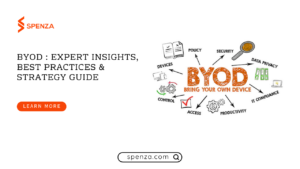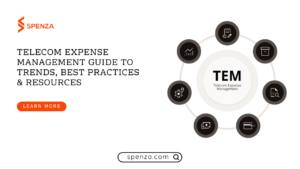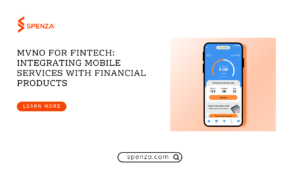Table of Contents
- How eSIM Fits in the IoT Environment
- Major Industry Applications of IoT eSIM
- How to Successfully Deploy eSIM Across Industries
- How and Where Spenza Fits In
- Conclusion
- FAQs

Is your organization exploring different ways to connect devices, systems, and people with minimal hassles? One way is to explore the services and solutions enabled by the Internet of Things (IoT). And why not!
The global pool of connected IoT devices reached 16.6 billion by the end of 2023, a 15% jump from the previous year. This number is expected to rise to 18.8 billion by the end of 2024.
Many industry analysts expect continued growth for IoT eSIM applications because of easier scalability and remote provisioning. A global eSIM connectivity strategy lets you handle coverage changes and adjust data plans from a central hub. That approach supports real-time decisions and helps avoid high roaming costs.
Industries like logistics, oil and gas, technology, and transportation often face operational challenges when managing connectivity across multiple regions and carriers. Embedded SIM (eSIM) technology helps streamline this by removing the need for manual SIM swaps and enabling remote carrier management.
With IoT eSIM applications, you get a practical solution for your business. You won’t have to juggle physical SIM cards since each device uses an embedded SIM that updates carrier profiles through software.
This approach helps cut administrative hurdles and even opens up global coverage. Let’s find out why it powers business growth and how Spenza’s solutions fit your large-scale deployment goals.
How eSIM Fits in the IoT Environment
eSIM is an abbreviation of embedded SIM. It’s a chip that remains inside a device and accepts over-the-air updates for network changes. Such an arrangement saves businesses from managing countless physical SIM cards through different mobile network operators (MNOs).

Remote provisioning is valuable if your business requires large deployments across multiple geographies. You can swap carrier profiles or tweak data plans directly, which helps a single site or an entire operation function without downtime. Some analysts offer eSIM growth stats that show a steady climb in global shipments. The global eSIM market is projected to grow at a CAGR of 7.9% from 2023 to 2030.
eSIM in IoT Deployment
As IoT deployments scale, businesses often find themselves managing thousands of devices across multiple countries, each with varying network conditions, regulations, and operator agreements. In such cases, eSIM alone isn’t enough. This is where connectivity aggregation platforms become essential.
They allow enterprises to manage connectivity from multiple carriers centrally, optimize data plans, and automate provisioning without negotiating contracts separately for each market.
How Spenza Can Enable eSIM Usage – A Real World Example
Spenza offers this exact capability by consolidating multi-operator management into a single interface. From procurement to monitoring and spend analysis, everything flows through one unified dashboard, eliminating fragmentation and manual effort.
Take logistics as a real-world example: a fleet management company might operate thousands of connected vehicles moving between the U.S., Canada, and Mexico. With traditional SIMs, switching networks across borders means physical swaps or roaming costs.
But with an eSIM powered by a platform like Spenza, those devices can switch to the optimal carrier in each region, based on signal strength, cost, or usage thresholds, without downtime or manual intervention.
These improvements aren’t just operational perks.
Faster carrier switching and centralized oversight also mean faster onboarding for new device rollouts, better performance analytics, and more stable service for your entire IoT ecosystem.
For your business, that translates to lower overheads, reduced downtime, and the ability to scale deployments with confidence.
Key Benefits of eSIM for Enterprises
Several businesses are already seeing the benefits of using eSIMs. Below are some of the major advantages you can enjoy.
- Reduced Downtime
Network or plan changes happen through software, which prevents service interruptions and keeps devices active. - Optimized Costs
You get an option to choose different carriers in various regions, which helps manage budgets. - Simplified Operations
One embedded SIM for each device eliminates confusion and manual swaps when requirements shift.
Major Industry Applications of IoT eSIM
Every industry has its connectivity challenges. Some struggle with coverage across vast regions, while others worry about stable service in tough environments. So, your decision to adopt this technology shows greater flexibility, faster setup, and smoother scalability. Each sector gains a unique advantage. Let’s find out in detail.
1. Logistics & Transportation
Fleets often drive in and out of different states or countries, which complicates data usage and roaming. An eSIM setup helps trucks or delivery vans switch carriers, avoiding coverage gaps.
Real-Time Telematics
Data on vehicle health, engine temperature, and location flows into central management systems through eSIM, which allows scheduling maintenance, improving driver routes, and reducing unexpected breakdowns.
2. Oil & Gas
Rugged sites pose extra challenges. One spot might have strong coverage from Carrier A, while Carrier B works better halfway down the pipeline. However, you can have an eSIM that provides gear operators a way to keep pumps or sensors online.
Remote Asset Monitoring
Oil and gas businesses need real-time visibility into remote assets like wellheads, pipelines, pumps, and compressors for safety, uptime, and regulatory compliance. Their sites may be located in offshore rigs, deserts, or other isolated areas.
So, managing connectivity for these remote assets at scale requires IoT eSIM to provision, configure, and activate thousands of remote monitoring devices without physical access. This is particularly valuable when rolling out or updating equipment across multiple sites or drilling zones.
IOT eSIM-enabled devices transmit critical telemetry data such as:
- Pressure and flow rates across pipelines
- Temperature and vibration data from rotating equipment
- Tank level and leak detection alerts
- Real-time health status of remote field units (RTUs)
Compliance and Safety Measures
Minimal downtime contributes to faster alerts and immediate responses to potential hazards. Crew members and managers see accurate readings, so site inspections become more proactive.
3. Tech & Manufacturing
Some factories load up on robotic arms that need constant connectivity. Shutting them down to swap SIM cards is not appealing, and that’s why you need eSIM to trim downtime and keep production lines rolling.
Automated Plants
Robotics, industrial sensors, and 3D printers need uninterrupted connectivity. Manufacturing eSIM setups deliver reliable links that do not require any physical replacements if a carrier change becomes necessary.
Scaling or Relocating
Production lines sometimes expand to new plants or relocate equipment. A single eSIM approach avoids the tedious process of procuring and installing fresh SIM cards.
4. Other High-Potential Sectors
- Healthcare eSIM
Medical devices designed for patient monitoring or hospital logistics must maintain strong signals, which are necessary for continuous data flow. - Agriculture eSIM
Farm sensors track soil moisture, weather conditions, and pest activity with embedded SIMs, eliminating the hassle of frequent replacements in rural zones. - Connected Urban Infrastructure
Usage in smart city eSIM plans supports metering, lighting controls, and public safety systems.
Let’s take a few example use cases across different industries:
| Sector | Core Requirement | eSIM Advantage |
|---|---|---|
| Logistics & Transportation | Multi-region fleet tracking | Automatic carrier swaps |
| Oil & Gas | Remotely located rigs/pipelines | 24/7 connectivity |
| Tech & Manufacturing | Automated plants and sensors | No physical SIM swaps |
| Healthcare | Patient monitoring devices | Consistent signal |
| Agriculture | Field sensors and remote farms | Flexible coverage |
How to Successfully Deploy eSIM Across Industries
There are multiple steps involved in deploying eSIM. Below, we’re highlighting a detailed step-by-step plan to show how each phase is carried out without confusion or costly mistakes.
#1. Assess Connectivity Needs
Teams measure current coverage, data volumes, and region-specific demands, which require an expense audit to begin with. This step requires:
Identifying Coverage Requirements
Start by conducting a geo-specific network performance audit across all operational zones—whether they’re last-mile delivery routes, offshore rigs, factory hubs, or cross-border fleet corridors. Analyze signal strength, latency, and data usage to pinpoint coverage gaps, dead zones, or high roaming costs so that your telecom and IT teams align carrier selection, optimize SIM profiles, and build rules for automated switching.
List Possible Carriers
Consider data usage patterns, device types, and hardware limitations to create a list of carriers that match your regions of operation.
Set Success Metrics
You’ll need to pinpoint strong metrics like average response time, data consumption, and monthly telecom cost. A baseline can help improve after rolling out IoT eSIM applications.
#2. Select the Right eSIM & Aggregation Partners
When choosing an eSIM vendor, you should focus on an aggregator that blends multiple carrier agreements under one platform and saves time. Spenza stands out for organizations that demand a single platform to manage everything from connectivity spend to mobility and API services. Here’s what you can consider.
Carrier Diversity
Multiple carrier relationships can be complicated to manage. Aggregation platforms simplify them by combining usage, billing, and analytics under one roof.
Billing Integration
One monthly invoice for multiple operators reduces confusion. If devices suddenly begin using more data than projected, check for aggregation that supports the mid-cycle plan.
#3. Implement Secure and Scalable Solutions
Encryption, device authentication, and network security are necessary to ensure that sensitive data stays away from prying eyes. People who oversee finance or healthcare eSIM setups pay close attention to security protocols for the following reasons.
Top-Notch Data Protection
Security is a key factor when deploying IoT eSIM applications. Connections must encrypt sensitive data and confirm device identities to avoid unauthorized access.
Role-Based Permissions
Specific employees handle different parts of your telecom or procurement chain. A well-designed aggregator solution, such as Spenza, can offer a super admin overview and assign permissions to each role to prevent unauthorized plan changes or untracked usage spikes.
#4. Monitor & Manage via Dashboards
Someone with hundreds (or thousands) of devices wants a clear view of usage. Detailed dashboards show data consumption, carrier info, and monthly bills.
For instance, below is the dashboard Spenza offers as part of telecom expense management.

Unified Monitoring
One dashboard can display data usage, active carriers, real-time costs, and possible roaming charges.
Alerts and Notifications
Messages about data threshold breaches or device offline alerts keep your teams updated.
Ongoing Analytics
Measuring usage trends allows you to adjust data allowances, budgets, or coverage options whenever needed. This data often uncovers new ways to deploy IoT eSIM applications in unplanned areas.
#5. Plan for Growth & Future Innovations
Once you decide to move to eSIM, there will be plenty of opportunities to leverage, especially as 5G matures. Large companies that handle enterprise IoT expansions can benefit from the agility to shift carriers when costs spike or better coverage arrives in a region.
Forecast Emerging Needs
Gauge expansions into new regions or add new device types so that your organization stays ready for shifting requirements. Manufacturing eSIM projects can benefit from cross-border supply chains, while healthcare eSIM might connect new patient monitoring tools.
Adopt AI and Machine Learning
Traffic patterns or sensor data might highlight coverage improvements or cost savings. Some solutions predict usage spikes and switch carriers ahead of busy periods.
Here’s the eSIM deployment checklist:
| Step | Key Activity | Target Outcome |
|---|---|---|
| 1. Assess Needs | Map coverage and usage trends | Identify the best carriers or plans |
| 2. Select Partners | Compare aggregator features | Unified billing + easy management |
| 3. Secure Setup | Encrypt connections and assign roles | Prevent breaches + track usage |
| 4. Monitor | Keep an eye on real-time data | Early warnings and cost control |
| 5. Future Plan | Anticipate expansions | Swift carrier changes + new ideas |
How and Where Spenza Fits In
Once your business is ready to scale eSIM adoption, Spenza brings the missing layer of control, automation, and visibility. It’s an operator-neutral IoT connectivity aggregation platform purpose-built to centralize everything from procurement to spend optimization.
Here’s how Spenza transforms enterprise eSIM deployment:
- Centralized eSIM management for multi-operator connectivity across regions—manage carrier profiles, provisioning rules, and usage controls from one platform.
- Procure-to-pay automation that eliminates the manual workflows between sourcing plans and reconciling telecom invoices.
- Live usage analytics & KPI tracking via the Spenza dashboard for better cost control and network performance.
- Smart plan assignment & switching that adjusts eSIM plans mid-cycle based on usage, preventing overspend.
- Global marketplace access to a curated set of operator plans that support B2B and B2C IoT deployments across industries.
Conclusion
With IoT eSIM applications, your enterprise can unlock broader opportunities. There is a range of embedded SIMs to suit large fleets, remote industrial sites, and high-tech production lines seeking fewer disruptions. As a specialized operator-neutral connectivity enablement platform, Spenza helps transform routine telecom work into a streamlined operation. You get the much-needed real-time performance data, shift plans on demand, and global scale.
FAQs
Unlike physical SIM cards that must be manually swapped, eSIMs are embedded in devices and can be remotely provisioned and updated. They enable businesses to change carriers, manage profiles, and scale globally without physical handling, making eSIM ideal for multi-region IoT use cases.
An aggregation platform simplifies the management of multiple carriers, plans, and geographies. It enables centralized billing, automated provisioning, and unified visibility across all devices, reducing operational complexity and improving control over telecom spend.
Spenza becomes a connectivity control hub for your business. It lets you manage eSIM profiles, automate plan switching, track live KPIs, and centralize procurement from one platform.
Yes. Many advanced eSIM platforms, including Spenza, offer API access for integrating with existing enterprise tools such as asset management platforms, ERP systems, or IT dashboards.
Yes. With eSIM, you can avoid roaming charges and select local carrier profiles dynamically, based on region, performance, or pricing. Such flexibility reduces telecom costs, especially for logistics, oil & gas, and tech businesses that operate in multiple markets.
Book a meeting with our telecom expense management experts and learn how Spenza can help contribute to your business by offering specialty connectivity.





